New York: MPG, asterisks, bad grammar
By John Gilbert
NEW YORK, N.Y. — The conclusion of the New York Auto Show on May 1 also ended the international auto show season for 2011, affording us an overview of a recovering automotive industry facing a struggling economy with rising fuel prices, and the coinciding demand for inexpensive vehicles with good fuel economy.
The New York show, at Jacob Javits Center, is now the nation’s largest-attended auto show, and indicates strides U.S. companies are making to take on the levels of style, technical, and luxury of the top European companies, and the price and fuel-efficient leadership from Asia, where Japanese companies themselves are challenged by the surging Korean tandem of Hyundai and Kia.
Audi got a jump on the show by holding a sneak-preview media launch of its new A7 sedan on the eve of the first press day at the show. Audi still has the compact A3, and recently introduced a new A6 sedan that fits between the midsize A4 and the luxury flagship A8, leaving little room for another niche vehicle in the Audi line, but the A7 will plug in where its numerical designation fits as arguably the best-looking sedan in the fleet. Audi chairman Johan de Nysschen said that while the A6 is outselling the Mercedes E-Class and BMW 5-Series in Europe and Asia, the company intends to have it do the same in the U.S. “The A8 and A6 fit nicely as full-size and mid-size,” he said, “and the A7 will appeal to buyers in both segments.”
At the A7 introduction, lead designer Ulrich Beierlein gave a presentation of what inspired him to draw all the curves and grooves on the sleekest Audi yet, a car that begins with an enlarged Audi family grille, and two parallel crease lines tracing the sides, with the upper crease curving upward to meet the rear pillar. The effect is a unique accent angle to make the sleek four-door sedan emphasis the fastback, coupe-like roofline. The A7 is loaded with futuristic connective technology, emphasizing new partnerships with Google-Earth, Wikipedia and T-Mobile, making the A7 a rolling WiFi hotspot. It is built with a lot of structural high-strength aluminum, and powered by a supercharged 3.0-liter V6 with 310 horsepower and 325 foot-pounds of torque. Thanks to an 8-speed Tiptronic transmisison, it claims instant responsiveness and highway mileage up to 28 miles per gallon.
German companies always have justifiable pride in their engines, but this time Audi is promoting a bit of confusion because of a “3.0T” badge on the A7 rear decklid. In Audi and VW nomenclature, “T” has always meant turbocharging, which is an exhaust-driven turbine that sends a blast of increased air-fuel into the engine, whether a TDI (turbo diesel injected) or the 2.0T (for turbo). Supercharging is a belt-driven power fan that force-feeds air to do the same thing. The 3.0T badge should thus mean the 3.0 is turbocharged, but another little badge on both sides of the A7 says “supercharged.” Audi executives tried to be flippant about it, saying we should now consider “T” to mean “charged,” whether turbocharged or supercharged. Since the two systems are so different, and Audi has always been so precise, that doesn’t add up, and when cornered, an Audi executive said,”I’ll look into it.” The charged-up new A7 is, officially, supercharged, thank you, and will be available by mid-May, at a sticker price of $59,250.
The show itself had numerous new attractions that were either global or at least getting first North American display after being shown in Geneva or Shanghai last month. The Javits Center is located just far enough from Midtown that we can declare it Off-Broadway, and if is an Off-Broadway show, Hyundai and Kia, which show no signs whatsoever of leveling off from their recent meteoric rise in stature, did their part to steal the show.
The U.S. “Big Three” also has been promoting high-mileage entries throughout the auto show season. The four major U.S. shows — Los Angeles in November, Detroit in January, Chicago in February, and New York in mid-April — have featured Chevrolet’s Volt and Cruze, and upcoming Sonic. Ford has the Fiesta and Focus. Chrysler has a highly efficient new V6 and its new owner, Fiat, offers its tiny new Fiat 500. While pushing high-mileage cars makes sense, the American “Big Three” tastefully withheld the recent heavy promotion of earlier unveiled and overpowering cars, such as GM’s Camaros and Cadillacs with supercharged Corvette 6.2-liter V8s, Ford’s variety of high-powered Mustangs, and Dodge Chargers and Challengers, plus the newly unveiled Jeep Grand Cherokee with available Hemi V8s up to 6.4 liters without supercharging.
As for new products, Chevrolet presented an all-new Malibu, with just enough revisions to remain between the larger Impala and the smaller Cruze, while resembling both. A new 2.5-liter 4-cylinder Ecotec has 20 more horsepower than the old 2.4, and has EPA estimates of 26 mpg city, and 38 mpg highway for the car, which will hit showrooms in early 2012.
Ford previously introduced its compact Focus and subcompact Fiesta, both attaining 40 mpg with special models, preceding the New York introduction of a revised Taurus, which will add the new 2.0-liter4-cylinder EcoBoost engine as an option. The EcoBoost indicates turbocharging, which will deliver 237 horsepower and 250 foot-pounds of torque, and will also get “at least” 30 mpg. Standard in Taurus will be the 3.5-liter V6 with increases in horsepower and torque to 297 and 255, respectively. The SHO high-performance Taurus continues with new styling touches and the EcoBoost 3.5 V6, turbocharged and with all-wheel drive.
Chrysler showed several new 300 models, and introduced the SRT-8 model of its totally new 2011 Grand Cherokee, meaning its Hemi can lay four patches of rubber, presumably, on burnouts, while taking you to the mountains it can also scale. Chrysler downplayed its outstanding new 3.6-liter V6 that will supply very good base power to all its vehicles. New owner Fiat has done some impressive things with the interiors of all Chrysler and Dodge models, and it goes its own way with separate Fiat 500s, including the unveiling of a cabrio model that has a nicely arranged full sunroof that slides back over the cabin.
Hyundai’s totally redone Accent subcompact comes in both sedan and hatchback, starting at a mere $12,445. Standard is a new 1.6-liter, dual-overhead-camshaft, 4-cylinder engine with the costly feature of gas-direct-injection (GDI) and 6-speed manual or automatic transmissions. Structures built with a lot of high-grade steel can be both lighter and stronger, and the 2,396-pound Accent is 182 pounds lighter than a Fiesta, making it simple to join the Elantra, the soon-to-be-released Veloster and some Sonata models in the over-40-mpg brigade.
Hyundai president John Krafcik assured any reluctant buyers that Hyundai’s rising residual value will now be bolstered by a guaranteed future trade-in value. Krafcik also tossed a clever dart at the misleading promotion of high-mileage competitors. He said that high price and lack of recharging infrastructure limit the new plug-in-electric Chevrolet Volt and Nissan Leaf, but there are others promoting 40 mpg — the Honda Civic FX, Chevrolet Cruze Eco, Ford Fiesta Super-Economy, and the Focus Super-Economy, the Smart fortwo, and the Elantra.
Krafcik said he wondered how they were all selling so Hyundai asked Edmunds.com for sales figures on all those special 40-mpg models for the first quarter of 2011. “Altogether the others sold just under 5,000 units,” said Krafcik. “We sold over 30,000 Elantras in the same time, so we were outselling all the other 40-mpg cars six to one for the first three months. We wondered why those others were not selling.”
The answer, he suggested, was the asterisks required on ads by competitors, which indicate, in fine print, that the car pictured wouldn’t get 40 mpg, and only specialty models costing a couple thousand more can attain 40-mpg.
Then he clicked on a video, showing a flock of animated blue asterisks blowing across the prairie like tumbleweeds. Actor Jeff Bridges did the voice-over, explaining how asterisks “once roamed free in this country,” but have recently become an endangered species because of all the auto companies who must use them to point out that their main models won’t hit the advertised 40. As the video goes on, the animated asterisks hide out behind trees like fugitives on the run, emerging happily only when a Hyundai Elantra approaches, with no need of an asterisk, because all of its models top 40. The video ended among laughter and applause from the usually cynical media, and was followed by cannons firing blue foam asterisks into the gathering.
Kia, with the benefit of Hyundai’s recent engineering brilliance as a subsidiary partner, unveiled its 2012 replacement for the subcompact Rio in both sedan and hatchback, sharing the same 1.6 GDI engine. An engine shutoff at idle should help the Rio fuel economy even more, and for less than $13,000, the Rio will be built out of 85 percent recyclable material.
Kia also introduced some styling and engine revisions to the hot-selling Soul, which hasn’t even been out two years yet. The new Soul will use the new 1.6 GDI or a 2.0, and officials promise greater use of the popular hamster commercial concept. Priced between $12,000 and $15,000, their stickers and their 40-mpg stature fit well as gas prices sail over $4 per gallon and head for $5.
High mileage was the buzzword from Japan, which started the trend years ago, but which is currently faced with production slowdowns because of the recent earthquake and tsunami. Mazda promises a makeover of its mainstream engines — major news from a company that will add “green-greeen” to its traditional “zoom-zoom.” Mazda officials vow their new Skyactiv gasoline engines will get the fuel-economy of a diesel, which is very good, and will bring to the U.S. a turbodiesel that will get the fuel-economy of a hybrid, which is even better. The diesel is coming to North America in two years. Meanwhile, Mazda said the Menagi concept SUV first shown in Geneva and on display at New York, will be built as the CX-5, using an all-new platform with Mazda’s all-new engines.
Honda introduced the long-awaited production model of its new-generation 2012 Civic, and features its extra-cost HF, which will reach 40-mpg. The same 1.8-liter engine remains in the new-bodied Civics, as does the unchanged 5-speed stick or 5-speed automatic transmissions, which drop Honda behind several competitors that now offer 6-speeds in both transmissions. The Civic Hybrid changes from nickel-metal hydride to a lithium-ion battery pack that is smaller and more potent, to combine with the 1.5-liter out of the Fit. The sporty Si is the only model that will get a 6-speed stick, although its “new” and larger engine with “more power” turns to have only four more horsepower by replacing the higher-revving — and more fuel-efficient — 2.0-liter gem with the larger 2.4 Handa has used with larger vehicles for two decades.
Nissan, which has moved past Honda as Toyota’s top challenger in homeland Japan, introduced a new Versa subcompact, which looks good, and should be a bargain with a base model starting at $10,990. However, after delivering the Leaf all-electric car, the subcompact Versa offers a disappointing highway maximum EPA rating of 37 mpg amid the flock of competitors’ 40-plus cars.
Toyota displayed its new iQ model of Scion, a tiny runabout which will be rolled out first on the East and West Coasts before venturing to the Midwest. Scion also will get the new FR-S sports car, so far only a concept, with a front-engine/rear-drive plan, with a Subaru-built “boxer” engine, low and flat-opposed pistons for a lower and sleeker set-up.
From Germany, Volkswagen has redone the “new” Beetle into, simply, the Beetle, with its arching silhouette peaking just slightly more toward the rear, as if hinting at more of a teardrop restyling, and it touts its 2.0 TDI turbodiesel which is clean and quiet and already proven for getting more than 40 mpg, with gusts to 50, along with the slick 6-speed DSG (direct sequential gearbox) automatic. March sales were reportedly the best for the company in seven years for VW, with the new Jetta doubling sales from March of 2010. Loyalty rates are up 46 percent among buyers, and conquests are up 106 percent. There is a hybrid engine in the Touareg SUV, but VW is most proud of its turbo-diesels. Jonathan Browning, CEO of VW of America, said customers are becoming more aware of the TDI models of Golf, Jetta, Passat and Touareg.
The new Passat TDI will get 43 mpg, and the Touareg, which is up 44 percent in sales, is up to 46 percent TDIs. The Golf TDI will come out with VW’s 4-Motion all-wheel-drive system, on its TDI model. VW also showed the concept Bulli, a squarish, vanlike vehicle that has a lithium-ion batter for electric drive, and an iPad for all driving and other information, fastened on the center console stack.
Along with Audi, Mercedes commanded plenty of attention with the North American showing of its new C-Class Cope and C63 AMG Coupe, and captured some economy-car impact with the Concept A-Class debut, with a live, but apparently lip-synching group of energetic folks from Mercedes TV ads, emerging from the audience to sing, “Oh lord, won’t you buy me a Mercedez-Benz?”
Porsche and BMW talked hybrids and electric power for the future, with a hybrid Panamera a breakthrough for Porsche. Saab, from Sweden, unveiled a high-styled and exotic sports coupe with a 1.6-liter turbo powering the front and an electric hybrid motor running the rear.
Mini, a subsidiary of BMW, attracted a large gathering to start the second press day with a performance by legendary rock band KISS. Photographers pressed close, prepared for a loud and raucus show, but when the curtains opened, there were only three members. Paul Stanley was away, tending to personal business, and apparently he’s the only member who can sing, because there was no music. Four custom-painted Mini Countryman 4-doors will be given away as Unicef charity auction donation, but the whole show fell flat because painted-face guys repeatedly sticking out their aging tongues, and a PR man painted up to look like a short and pudgy KISS member, were humorous parts of a much-hyped show that misfired.
As cars get more high-tech, sometimes the advertising and promotion can’t keep up. Advertising copywriters for Honda appear to be trying to dumb down prospective buyers of the new Civic. Honda’s advertising and promotion have lagged sadly behind the company’s technical brilliance for two decades. Recently, Honda’s television ad campaign about really big deals shows salesmen trying to operate enormous, 20-foot tall calculators, or saying everything in the showroom is such a big deal that salesmen are shown crushed under gigantic donuts. We come away more convinced that their electronic gadgets and their snacks are bigger than the bargains. Ads accompanying the 2012 Civic introduction have hit a new low, however. The Civic was introduced as it sat on a raised stand, behind which giant letters spelled out: “TO EACH THEIR OWN.”  Of course, the old saying “To each his own,” uses “his” as a collective meaning both genders. Apparently RPA, Honda’s ad agency of 29 years, couldn’t think of any other phrase, and decided that to be more politically, and genderly, correct, it had to ruin the phrase and slaughter proper English usage.
John Mandel, vice president of Honda America, was using the now-common teleprompter as he finished explaining that the 2012 fleet of Civics will range in price from $15,605 for the base DX to $24,050 for the hybrid. Mandel concluded his presentation, by saying, “remember…to each his own.”
I caught Mandel privately afterward, and asked him: “Did the teleprompter really say ‘To each his own,’ or did it say ‘To each their own?’ ”
Mandel caught on immediately, smiled, and said: “I’ll never tell. That’s going to have to go down as a mystery of the ages…But I will say, I live with an English teacher.”
Perfect. At least Honda is still trying to be high-tech, even while its advertising agency is proving itself to be semi-literate.
UMD takes final bow at AMSOIL Arena
By John Gilbert
Before UMD embarked on its fanciful flight to the NCAA hockey championship, my suggestion to Bulldog fans was to savor every second of it, because no matter how good your team is, there are no guarantees, and the chances to win an NCAA title can be — as the late Waylon Jennings would put it — “far and few between.”
The celebration for the team, a week ago now, at Amsoil Arena, was heartfelt and brief, for a crowd estimated at between 3,000 and 3,500. It was less brief for the players, who were honored on a set of bleachers down on the arena floor, with fitting tributes from Mayor Don Ness, new chancellor Lendley C. Black, coach Scott Sandelin, assistant coach Brett Larson, and captain Mike Montgomery.
Then the players went up to the concourse and signed autographs, from about 7 p.m. until after 11 p.m.
Somebody said that they expected more fans than what showed up, but realistically, waiting four days for the official celebration undoubtedly allowed some of the fans to cool off a bit, and there might have been others still at home, swooning.
“Is this starting to settle in with anybody? It’s still a surreal experience for me,” said Montgomery, one of four seniors who played against Michigan in the 3-2 overtime victory.
He went on to thank the university for “letting us play hockey and pursue an education at the same time. We got to say goodbye to the DECC and christen this new building. And hopefully, now that we’ve broken the seal, this can be the first of many championships.”
That’s the key. The Bulldogs were winning their first NCAA men’s Division 1 championship in hockey, or in any sport, for that matter. Michigan, on the other hand, was going for its 10th, and has the record for NCAA and Frozen Four appearances. But if you look it up, most of those were in the old days, when the East designated two teams and the West — which later became the WCHA — designated two teams. They’d go somewhere and play each other, semifinals and final. Coach Red Berenson has been running the Wolverines program for 27 years, and he has won only two NCAA championships, despite getting there almost every season.
Michigan’s two titles came in 1996 and 1998, and if you ask Berenson, the 1997 team was his best — the one that had seven 20-goal scorers. But they got beat. The lesson is, you jump at the chance when it comes around, and you don’t waste time thinking that you might have a better chance next season. Consider North Dakota. The Fighting Sioux were the best team in the country down the stretch, right up until losing 2-0 to Michigan in the semifinals. The Sioux players now will tell you that the season was not a success, despite winning the WCHA, the playoffs, the Midwest Regional — because they didn’t win the NCAA championship. Dave Hakstol is one of the best coaches around, and he has taken numerous outstanding Sioux teams to the tournament. But the Sioux have yet to win the NCAA under Hakstol, which seems an aberration.
The Bulldogs won it under coach Scott Sandelin, and they will raise their banner high next season, when, on paper, they could be even stronger.
But as soon as the celebration ended, word came that junior Mike Connolly had signed a pro contract with San Jose, passing up his senior year. The next day, freshman defenseman Justin Faulk signed with Carolina, as expected, and will pass up his final three seasons. Now Sandelin himself is heading off to Penn State to talk to the Nittany Lions about moving there and starting a new program.
If we’ve learned anything from all those years of not winning before winning by surprise this year, we aren’t going to hold our breath until next season. We’ll just wait and see. Meanwhile, we can savor the moments of victory at Xcel Energy Center in Saint Paul, and we can include that celebration at Amsoil Arena.
Mayor Don Ness spoke first, and talked about how proud the City of Duluth is, and how Governor Mark Dayton had proclaimed that very day, Wednesday, as UMD Bulldog Hockey Day in Minnesota. “As mayor, I get to make a proclamation, too,” Ness said. “I hereby proclaim that on behalf of hockey fans in Duluth, every player on this team with remaining eligibility returns next year and wins another championship.”
Sounded good at the moment, although Ness had heard that Connolly and Faulk were gone to big-money pro contracts.
Chancellor Black, who just took over and must think all is well after his new university won the Division II football title and now the Division I hockey championship, pulled out a sun visor, to which a blond wig had been attached, as he took the podium. He put it on, so that he would show unity with the players on the team, almost all of whom had dyed their hair blond for the playoffs. Black talked about the comments and messages he has received congratulating UMD for the accomplishment, and Bulldog fans for their demeanor.
“Our last three opponents,” Black continued, “were Michigan, Notre Dame, and Yale. Those are all three outstanding institutions academically as well as athletically. That’s good company to be in…It’s an opportunity for UMD men’s hockey to join and remain among the elite teams of college hockey.”
Brett Larson, former player and now assistant coach, who shaves his head to keep up with a once-receding hairline, took the podium next. “I don’t care what anybody says,” Larson said to chancellor Black. “I think your hair looks great. I’d take it.”
Larson, who recalled the recent pain as assistant coach when UMD lost to Miami of Ohio two yeas ago, also talked about how being part of UMD’s hockey alumni, which is as much a family as the Bulldogs team was this past year. “And I’d like to welcome our seniors into our family,” Larson said.
After Larson and Montgomery talked, Sandelin got his turn. “Brett has been with me for three years,” Sandelin said. “And he hasn’t lost his hair from the job — he started that way.”
Sandelin added how proud he was of his 26-man roster. “This group, some who have been playing since we lost to Miami, last year didn’t get into the tournament,” Sandelin said. “We talked about where the tournament was this year — Saint Paul — and what we’d have to do to get there. They have to deal with me on a daily basis, so give them tremendous credit.
“Some said we were in a slump at the end of the season, but when you’ve never lost two games in a row all season, I don’t know if it could be called a slump.”
That’s us bozos in the media, Scott, I confess. You fooled us by not losing two in a row, but going winless in three straight, with a loss, a tie, and a loss, during a 2-4-2 stretch over the final eight games of the regular season. For a team that had a chance to win the league title, 2-4-2 is a slump, baby.
“I knew this would be big in Duluth, if we could do it,” Sandelin added. “I’ve always believed you could win in Duluth. And this is just a start.”
Then they played highlight videos on Amsoil’s big screen of the NCAA tournament victories, over Union, Yale, Notre Dame, and Michigan. Getting hot at the right time is what matters, once you’ve qualified for the NCAA. North Dakota came to the Frozen Four on a 15-game unbeaten streak, and was shut out in the semifinals. UMD? Well, Scott, we’ll forget that 2-4-2 homestretch, and swap it gladly for a four-game NCAA tournament winning streak.
HIGH SECURITY
Another passing of the torch came Tuesday of this week. On the day the Bulldogs won the NCAA title at Xcel Center, I suggested to the fellow sitting next to me that the Minnesota Wild should sign Justin Fontaine, who was just completing his senior season, and put him to work the next day, Sunday, in their last game of the NHL season against Detroit. Let’s see now,
Fontaine is a skilled and creative puck-mover and goal scorer, and the Wild desperately needs to find a playmaker and goal-scorer…So on Tuesday, their season done, the Wild announced they have signed Fontaine. That makes Fontaine, Mike Connelly, and Faulk — three NCAA champion Bulld0gs heading for, hopefully, the NHL.
Another NHL image came into focus as I was moving through the Minneapolis-Saint Paul International airport security line later Tuesday. I was heading toward a flight to New York for the New York Auto Show, and as we emptied our pockets into the trays for security check, I noticed a very large, dark-skinned, broad-shouldered young man right ahead of me, wrestling to put all the proper items in the trays. I recognized him right away. It was Dustin Byfuglien, the former Roseau kid who burst onto the North American hockey scene last season when he played a vital role as a tough winger or defenseman who also had great hands and could score, helping the Chicago Blackhawks rush through the NHL to win the Stanley Cup Playoffs.
I introduced myself to him as someone who has long been a follower of all things Roseau in hockey, and how at the start of the season, I wrote that the Blackhawks would miss Byfuglien much more than Byfuglien would miss the Blackhawks, after Chicago made its choices of who to protect and who to let go through free agency, and Byfuglien was odd man out. He ended up in Atlanta, where he had a strong season on a team that missed the playoffs. The Blackhawks, meanwhile, only made the playoffs as the West’s No.8 seed on the final day of the season, and only because the Minnesota Wild beat Dallas to let Chicago sneak by.
Not coincidentally, as I was driving from Duluth to Minneapolis last Sunday, I found the Chicago broadcast of the Blackhawks game at Vancouver on satellite radio. The Canucks, who had the best record in all of hockey, had beaten Chicago in Game 1, and they broke from a 2-2 tie with two goals in the third period to take Game 2 4-2. In the closing minutes, Troy Murray, the Hawks color analyst, mentioned that 6-foot-8 John Scott was being sent out to play a key role and give Chicago some much-needed muscle. “He’s trying to fill the role Dustin Byfuglien played last year,” said Murray. “But John Scott is no Dustin Byfuglien.”
Barely one day later, I encountered Byfuglien in the Twin Cities airport, after he spent time trying to find a home for the summer. Byfuglien said he enjoyed playing in Chicago, but he likes Atlanta, too. However, while Atlanta is nice, it isn’t so nice in sweltering summertime. Meanwhile, the Hawks have come from being down 3-0 in games against Vancouver to winning back-to-back blowouts to regain hope against the suddenly shaky Canucks.
Speaking of the Stanley Cup Playoffs, did you catch the Detroit game the other day, when the Red Wings won 4-3 against Phoenix? Pavel Datsyuk scored a goal and set up three others, which is about all the points you can get out of four goals. Interesting that with Sidney Crosby still sidelined by post-concussion problems, the golden boy who has been the only player the NHL has promoted for two years leaves only Alexander Ovechkin of Washington as the East’s best draw. Maybe Ovechkin is the best player even if Crosby and Malkin are back. But in the West, along with Vancouver’s Sedin twins, there are a number of great players. None might be better than Datsyuk and Henrik Zetterberg of Detroit. Trouble is, Zetterberg missed the whole stretch drive with a knee injury, so that left Datsyuk as possibly the beste individual player in the West. He upheld that theory in the first playoff round, when the Red Wings didn’t have to rush Zetterberg back because they had Phoenix covered in four straight games. Reunited, the two might put on quite a show in the next round.
Regardless, the series I most want to see in the entire playoffs would be Detroit against Vancouver, as long as the Canucks regain their form and get past Chicago. If that happens, Zetterberg rejoins Datsyuk to lead the highly skilled, but aging, Red Wings against the NHL’s newest superpower in Vancouver. Winner take all, and I don’t mean just in that series.
Mazda5 a mini-minivan with Zoom-Zoom
By John Gilbert
SAN DIEGO, CALIF. — Through good times and bad, Mazda has held true to its ‘Zoom-Zoom” image. Its vehicles may vary, but they always rank high in the fun-to-drive quotient. The 2012Â Mazda5 shines as the latest example, proving that even a mini-minivan can zoom.
Mazda would prefer to call the Mazda5 a “Multi-Activity Vehicle,” but the chances of adding MAV to the consumers’ automotive lexicon is remote. Mazda officials therefore won’t shrink from accepting similarities to a shrink-wrapped minivan. Other companies might be reluctant to promote minivans these days, and while I think it’s a stretch to call the Mazda5 a minivan, but Robert Davis, senior vice president of production, development and quality, says the Mazda5 has “the body of a minivan and the soul of a sports car.”
On the other hand, Tetsu Nakazawa, Mazda’s manager of product planning and strategy, says: “The Mazda5 does not fit into any segment. It’s characterized as a minivan by some because of the seat arrangement, while others say it’s a compact in the C Segment, and Consumer Reports calls it a wagon. It is the hidden gem in our lineup, because people who look at it expect two rows of seats and find three rows, then they are surprised at how fun it is to drive, and they are further surprised because its price starts at under $20,000.”
And they didn’t even get into one of my favorite asset, which is sliding side doors, which could be called parking-lot proof.
Officially, the base price is $19,990, although to stay $10 under $20,000, Mazda makes you add the $795 destination price yourself. Still, the standard equipment is a lengthy and impressive list. The basic Mazda5 is the Sport, which has 16-inch alloy wheels, power windows, locks and cruise control, plus keyless entry. Next up is the Touring model, which comes with the 5-speed automatic standard and 17-inch wheels, optional on the Sport, are standard, as are Bluetooth connectivity, foglights, and a rear spoiler. The Grand Touring is above that, with leather heated seats, a power moonroof, rain-sensing wipers, a 6-CD changer, and anti-theft devices. The moonroof and audio packages are options. Read more
UMD had all the ingredients, plus magic
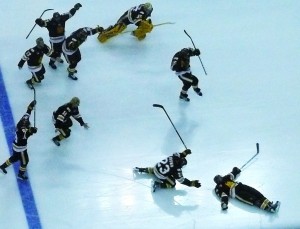
Kyle Schmidt raced down the ice, then slid feet-first after scoring the winning goal in UMD's first NCAA championship game.
By John Gilbert
How did they do it? How did this UMD men’s hockey team get itself gathered up to win its first-ever NCAA Division I hockey championship. All the right ingredients were there, without question, from speedy and high-scoring forwards to tough and agile defensemen, and on to clutch goaltending — but there were a dozen other teams that had those assets, too, and several of them were, frankly, playing better hockey down the stretch than the Bulldogs. How did it all come together?
Simple. It was “magic.”
That quality can be called a lot of things, from luck, to chemistry, to being a team of destiny. This season’s Bulldogs qualify for all of the above, but it’s easier to simply call it magic. That best explains how, at 3:22 of sudden-death overtime, a senior from Hermantown named Kyle Schmidt skated across in front of the Michigan net, from right to left, having spotted Travis Oleksuk, his centerman, behind the net with the puck. Oleksuk, who had scored earlier himself, passed it out front and in an instant, Schmidt had banged it past goaltender Shawn Hunwick and the demons of 50 years suddenly dissolved. “I saw it go in, and started skating for the other end,” said Schmidt.
The 3-2 victory provided ended a great hockey game, and instead of waiting to be mobbed by his teammates, Schmidt raced down the ice, crossing the far blue line before he threw himself into a feet-first slide, as his teammates on the ice raced after him, only slightly ahead of the rest of the Bulldogs pouring off the bench. For a brief moment, Schmidt was sliding along, all alone, looking up at Xcel Energy Center’s rafters, above the seats filled with 19,222 screaming fans — alone with his magical moment, an isntant before being absolutely mobbed.
“It was amazing,” said Schmidt. “It’s great for the players, coaches, everyone here to win the championship, but I think it’s been ‘way too long coming, for everyone in Duluth, the Twin Ports, anyone Up North, and all UMD fans. To be around 50-some years and not have won it, but to have been so close back in ’84 — 27 years ago — and now to finally bring it home…It’s for everyone. It’s awesome.”
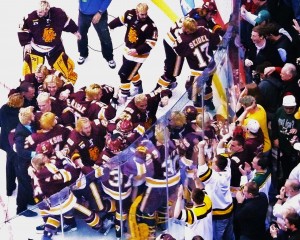
After 50 years of disappointment and frustration, the Bulldogs celebrate an NCAA men's championship.
It was even magical that Kyle Schmidt could summon up the image of the only other time a UMD team made it to the championship game, since he was three years from being born, in 1984. The four-overtime loss to Bowling Green remains a painful memory to all UMD fans who were alive at the time, and, perhaps surprisingly, remains a haunting heartbreak to the players on that team. You could almost feel the pain of that memory lifting as Schmidt went broad-sliding across Xcel Center’s ice surface.
Coach Scott Sandelin said he was speechless, in the post-game interview room. “When I came here 11 years ago, I left a team that won a national championship — actually, two in three years,” said Sandelin, recalling his time as an assistant at North Dakota. “I was willing to accept this challenge because, growing up in Hibbing, I believed you could win here. Sometimes you’ve got to go through some rough patches, and we have. We’ve had a staff that has worked hard, and we’ve recruited some great kids. There are so many good teams, but sometimes the chemistry and things have to go right. You have to get luck. And we certainly had the luck in overtime.”
Sandelin had his own recollection of UMD’s only previous NCAA final, because coach Mike Sertich’s Bulldogs beat North Dakota 3-2 in the semifinal in that 1984 tournament, and Sandelin was a North Dakota defenseman.
“The close call in 1984 comes back, but it stings the players more than me,” said Sertich, who coached UMD to that indelibly inscribed finish, and who returned home from the final step in a sequence of surgical procedures for blood clots that felled him in February, from last summer’s ankle surgery, just in time to see UMD’s 4-3 victory over Notre Dame in last Thursday’s semifinals. “I thought about it for a while, but there were other teams to coach, and I never realized how much it has stayed with guys like Tom Kurvers, and Mark Odnokon, or Norm Maciver, and Billy Watson.”
As a college student, I got serious about watching the UMD hockey program as sports editor of the UMD Statesman, back when they were in the MIAC, running up huge scores against all their opponents, while enjoying the unfair advantage of being able to play in the Curling Club, a wonderful place compared to the outdoor rinks of their competitors. I watched them make the bold move, under Ralph Romano, to Division I and enter the Western Collegiate Hockey Association, where they didn’t win much because they mostly were fighting for their hockey lives against super-powers from North Dakota, Michigan Tech, Denver, and Michigan, plus their good-ol’ Big Brothers from Minnesota. I was there when they opened the DECC and Huffer Christianson recorded a record six assists in an 8-1 debut game against the Gophers.
It took UMD awhile to build up to competitive speed, in the toughest league in the country. Bill Selman had some outstanding teams, and Gus Hendrickson laid the groundwork for his assistant, Mike Sertich, to take over and make his run at league titles in 1984 and 1985. It was the 1983-84 season that left the deepest wound. UMD had a wealth of players, led by the goaltender I rank best of all in Bulldog history — Rick Kosti. He was ably backed up by Jon Downing, but Kosti played 38 games in the 1983-84 season, with a record of 27-9-2 as UMD won its first WCHA championship. Kosti, incidentally, came back and played a school record 45 games the next season, going 33-9-3 for the most wins in a season for any goaltender, as UMD won the title again. Kosti’s 60 career victories are the most for any goalie in UMD history, and he only played two seasons — both WCHA championship seasons, the only ones in UMD history, until the Derek Plante-led Bulldogs won it again in 1992-93.
Forwards on that 1983-84 team included Bill Watson, Mark Odnokon, Skeeter Moore, Mark Baron, Tom Herzig, Bob Lakso, Matt Christensen, Jim Toninato, Sean Toomey, Bruce Fishback, Brian Durand, and Brian Johnson, and the defense was led by Tom Kurvers, Norm Maciver, Jimmie Johnson, Guy Gosselin, Bill Grillo, and Jim Plankers. To know how those players measured up with the rest of the country, consider that Watson scored 35-51–86 that season, numbers he eclipsed a year later with 49-60–109 — UMD’s record for assists and points in a season. Kurvers, meanwhile, as senior captain in 1983-84, scored 18-58–76 from defense, records for assists and points by a defenseman in a season, and he went on to record the most career points for a defenseman at 192 for his four years. Maciver, another magician with the puck, broke Kurvers’ record for most career assists by a defenseman a couple years later with a four-year total of 152. That group of Bulldogs also claimed successive Hobey Baker Awards, with Kurvers winning in 1984 and Watson in 1985.
College hockey is a different world now, but that 1983-84 team was special. Ralph Romano, who coached the first D1 UMD teams before devoting all his time to being athletic director, had suffered a heart attack at a midseason game against Denver, and died. The team carried on, dedicating the rest of the chase to Romano. I had the opportunity to travel to Lake Placid, where I had been for the 1980 Olympics, and this time could enjoy covering UMD — “Minnesota’s Team” — for the Minneapolis Tribune. We rode out on the UMD-commissioned charter flight. The Bulldogs beat North Dakota on Watson’s overtime goal in the semifinals. “People forget that North Dakota had a goaltender named Jon Casey that year,” said Sertich. The next day, Kurvers was named UMD’s first Hobey winner.
Surely, Bowling Green couldn’t cope with this arsenal, although as a fairly objective reporter, no assumptions were made. UMD was cruising along, leading 4-2, but in the Olympic Arena press box, there was no deja vu about 1980. When the U.S. beat the Soviet Union and went on to Olympic Gold, it was truly the Miracle on Ice; this time, the Bulldogs were the best, ranked No. 1 in the country, and they were headed for UMD’s first NCAA title with just about the same amount of “favorite” as the Soviets had in 1980. Oops.
Bowling Green got a goal, closing it to 4-3. That made it tense, for sure, but UMD played it sure-handed, backing off from its prefered attack mode to ride out the closing minutes, as they ticked down to only a couple. A Bowling Green player, unable to attack, threw the puck up the right boards and into the UMD zone. Routinely, Kosti went behind the goal to tee it up for his defensemen. As he got to the end boards, the puck hit a seam in the right-corner boards and the puck glanced crazily directly out to the slot. Before Kosti could react, a Bowling Green skater rapped the puck into the unguarded goal, and it was 4-4. “It was funny, because being there and watching it, there was more of a feeling of disbelief,” said Sertich. “Did I just see what happened? I was more shocked than anything.”
Because UMD had never won an NCAA title, there was still a feeling of unproven underdogs. “No question, the teams that had a tradition of winning national championships play with a little swagger, compared to being awe-struck, the way other teams are,” said Sertich. It wasn’t awe, by then in that championship game, just uncertainty, which swept through the press box like a fog rolling off Lake Superior. It created a hollow feeling, as the teams battled through overtime, because the certainty that the Bulldogs were headed for the national championship was replaced by a sincere hope that they could still prevail. The uncertainty grew through a second overtime, then a third. In the fourth, fatigue was becoming obvious, but suddenly Bowling Green scored. The game was over, and Bowling Green had won 5-4 in four overtimes. Rick Kosti had made 55 saves.
The next year, UMD again won the WCHA and again was the favorite going into Detroit for the Frozen Four, which was “allowed” to be called the Final Four back then.. The Bulldogs faced RPI in the semifinal, and while Kurvers was gone, a new player named Brett Hull had shown up, and Kosti set his record, Watson scored enough to win the Hobey, and surely no ECAC team was going to derail the Bulldogs. But RPI did it, in three overtimes. That left the 1984 team as the only one to get to the final, although the run of great success convinced UMD fans that it would be just a matter of time until one of these great teams would break through.
Bill Watson is now a volunteer assistant coach with the Bulldogs. Tom Kurvers and Norm Maciver work in player personnel and scouting with NHL teams. During the playoffs, it was fun to talk to Kurvers and Maciver about the Bulldogs. They agreed that the greatest natural leader of any Bulldog team was Odnokon — “Ozzie” — who was a forceful winger and a dominant personality. Sertich recalled that on one of his teams, they had a miserable practice after returning to the ice from holiday break. “I lined ’em up and said, ‘Anybody who was NOT out late last night, step forward,’ and nobody did,” said Sertich. “I didn’t realize until later that Odnokon had told the team that they were all going out together, and everyone did. That’s the power he had.”
Flash forward 27 years now, to the Xcel Center press box. Just before the final game was to start, the fellow directing media at the press box entrance came and summoned me because a couple fellows wanted to talk to me. I went out by the elevators, and there they were — Kurvers and Odnokon. We talked for about 5 minutes, then they had to head for their seats. It was one of those sessions where I think they were burning off a little nervous energy, maybe trying to carve through a little of that 27-year-old hangover.
As I returned to my seat, I spotted Kevin Pates, an always-friendly reporter from the Duluth News-Tribune, who’s been covering the Bulldogs for years. I told him I wish I had come and gotten him, because he would have enjoyed saying hello to Kurvers and Odnokon. Pates, who is a diminutive fellow, smiled, and recalled instantly back in that 1983-84 season when Kurvers and Odnokon stopped by his hotel room, allegedly to talk. “They wrapped me up in a blanket, and stuffed me into the shower,” Pates said. Sertich got a laugh out of that: “They ‘mummied’ him,” he said.
If you were betting on it, if you knew that UMD’s mighty first line would be harnessed all night and not only fail to score a goal at even strength or on the power play, and would, in fact, be outscored by Bill Winnett from Michigan’s checking line, you wouldn’t give UMD much of a chance. And if you knew that Michigan would also get a goal to tie the game 2-2 from fourth-line center Jeff Rohrkemper, the odds would slip further. And if you knew the game would broil on into sudden-death overtime, you might have trouble with the realization that just a month earlier, Duluth East and Hermantown had come to the state high school tournament on the same Xcel Energy Center rink, and East in Class AA and Hermantown in Class A both lost — in overtime.
But the Bulldogs got to that overtime by having invented other ways to survive. Travis Oleksuk, junior center on the second line, scored one goal, lifting UMD to a 1-1 tie early in the second period. A few minutes later, Max Tardy, a little-used but highly-skilled freshman from Duluth East, who had been inserted as fourth-line center just before the playoffs, came out on the second power-play unit and scored his first collegiate goal for a 2-1 UMD lead. Michigan tied the game 2-2 later in the second period, and the scoreless third period ended, signalling overtime, and undoubtedly signalling a collective sinking feeling among UMD’s veteran fans. Not again. Not another excruciating, wrenching close call to be snuffed in overtime.
Here’s Michigan, full of high-tempo swagger in pursuit of its 10th NCAA title, and there were the Bulldogs, with no tradition of winning national championships in their arsenal. Time for more magic. Schmidt, whose injury during the East Regional gave coach Scott Sandelin the idea to put Tardy on the second power-play unit as a replacement, had just won the college hockey commissioner’s award as the nation’s unsung hero for the season. It is an award that goes to a hard-working and honest player, but definitely to someone who has managed to play well while avoiding being the guy in the spotlight.
It was Kyle Schmidt, a senior from Hermantown, who spotted Oleksuk’s move behind the net, and went for the slot, and who banged in Oleksuk’s pass. It was a quick, stunning goal. A one-timer, in more ways than one. It sent Schmidt racing to the far end of the rink, to his broadslide that could have been the aftermath of ESPN’s Play of the Day. The goal gave UMD its eighth victory in overtime this season, its first NCAA championship ever, and with the power to eliminate all those demons from 27 years ago, to say nothing of a proper way to celebrate 50 years of Division I hockey. After the game, Kurvers and Odnokon were down at the UMD dressing room, where they could join Watson. The current Bulldogs brought out their trophy, so that Kurvers and Odnokon could heft it for a magical moment.
To win a championship, it takes skill, determination, strong skating, hitting, defense, goaltending, and a tenacious and resilient character. But all of those ingredients can’t do it alone. They also need a little magic.
Schmidt’s OT goal gives UMD NCAA title
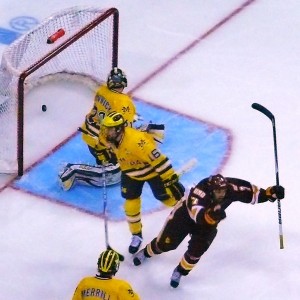
Kyle Schmidt scored the overtime game-winner for UMD's 3-2 victory over Michigan, and immediately skated the length of the ice to celebrate.
By John Gilbert
Kyle Schmidt found the perfect ending to his Minnesota-Duluth hockey career, scoring at 3:22 of sudden-death overtime Saturday night to give the Bulldogs a 3-2 victory over Michigan. It was Schmidt’s 11th goal of the season, the biggest goal of his life, and the biggest goal in the 50-year history of UMD hockey, because it came in front of 19,222 fans at Xcel Energy Center and gave the Bulldogs the first NCAA Division I men’s hockey championship in program history.
Schmidt, a senior from the Duluth suburb of Hermantown, has not always had great timing this season. He broke his hand in practice the day before UMD played its ceremonial first game at its new AMSOIL Arena in Duluth, and he was later injured during the East Regional. But he overcame all the adversity and played well enough to regain his spot on the second line and be presented with the National Unsung Hero award, given each year to a good player and dedicated worker, but also someone who has not been a heavily publicized star.
Schmidt fouled that up, pretty thoroughly when he skated in from the right side to score with a pass from Travis Oleksuk behind the net. As heroes go, Schmidt instantly went from unsung to “sung.”
It was a night for unsung heroes, as UMD’s high-powered first line was held off the scoresheet by Michigan’s hustling and persistent Wolverines. Oleksuk and Schmidt picked up the slack with goals for the second line, and lightly used freshman fourth-line center Max Tardy scored his first collegiate goal on the backup power-play unit. Michigan got into the spirit of the night too, taking a 1-0 lead on Ben Winnette’s first-period goal, and tying the game 2-2 when fourth-line center Jeff Rohrkemper scored late in the second period for the 2-2 deadlock.
“That’s what often happens in a game like this,” said Michigan coach Red Berenson. “The top players just about neutralize each other, and usually an unsung guy gets the big goal.”
Michigan (29-11-4) was making a bid for its 10th NCAA championship and third in Berenson’s 27-year coaching career. His two titles were both won by 3-2, for good measure. But the CCHA champions didn’t intimidate the Bulldogs (26-10-6), who played with the confidence they have maintained while establishing a remarkable 7-2-6 record in overtime games this season.
“I’m so extremely proud of this team,” said UMD coach Scott Sandelin. “Not just for the players, but for the alumni, the city. I’m just excited for these players to have this experience.”
There also was some further kharma going for Schmidt, was the only player who didn’t dye his hair the outrageous bleach-blond his teammates decided to use for team playoff unity. His teammates didn’t seem to mind, and they definitely didn’t mind after Schmidt ended Saturday night’s game. At the post game press conference, someone asked if leaving his hair its natural color was responsible for scoring his game-winner. Schmidt paused and then deadpanned: “Yes.”
Schmidt is getting married in a few weeks and his fiance didn’t want him fouling up any wedding pictures by looking like a latter-day beach boy.
The Bulldogs outshot Michigan 38-24, but never had the upper hand against the tenacious Wolverines, who are almost an annual fixture in NCAA tournament time. “Good for Minnesota-Duluth,” said Berenson. “They were a better team than we thought during the season. They were kind of under the radar. I thought our penalty-killers were dialed in, and they have they have a terrific power play — the best we’ve seen all year.”
Berenson was not impressed with the officiating of Eastern referees Tim Benedetto and Jeff Bunyon, who gave Michigan nine penalties to four for UMD. “Every time somebody falls down there doesn’t have to be a penalty,” Berenson said.
As higher seed, Berenson had last change and started his veteran defensive line, with Matt Rust centering fellow senior Ben Winnett and junior Luke Glendening. Even counting Winett’s fourth goal of the season, the game-winner in the 2-0 semifinal shutout over North Dakota, the three linemates came into the final with a total of 17 goals — fewer than any of the players on UMD’s top line — Jack Connolly with 18 goals, Mike Connolly with 28 and Justin Fontaine with 22. But with Winett scoring his fifth goal in the final, the checkers outscored the checkees.
The closest UMD’s top unit came to scoring was a power-play blast from the right side by Jack Connolly that rang the short-side right post. Shortly after that, Michigan appeared to score, when Carl Hagelin poked a rebound from under goaltender Kenny Reiter, who had been sitting on it for a couple of seconds, but the ECAC referees waved it off for coming after the whistle.
At 14:42 of the opening period, the Wolverine succeeded in their role-swapping, when Rust won a left-corner faceoff back to Winnett, who skated to the slot and shot off defenseman Justin Faulk’s skate and into the left edge of the net for a 1-0 lead.
It wasn’t until the second period that UMD’s second line proved it was possible to get a puck past Michigan goaltender Shawn Hunwick, whose semifinal shutout had subdued North Dakota. T.J. Brown slid the puck out to the right point, where Brady Lamb faked a shot, stepped in and shot, with Oleksuk knocking in the rebound from the right edge to tie the game 1-1 at 1:39 of the second period.
The Bulldogs finally clicked on their fourth power play to gain a 2-1 lead, but it was after the first unit had gone to the bench. Tardy, recently plugged into the lineup because of his puck-handling prowess, was in the left corner for a pass from Lamb, who assisted on all three UMD goals. Tardy stepped out and tried to pass across the goal-mouth, but Hunwick blocked the pass right back to Tardy, who deposited it into the net at 9:31.
“I just tried to stay calm, like we were playing shinny hockey, and it worked out,” said Tardy. “It’s a tremendous feeling to be part of the first UMD team to bring home the championship.”
A flurry of penalties had been settled up later in the second period, and just after a power play ended, the Wolverines got the 2-2 tie. Greg Pateryn’s hard shot from the left point hit Jack Connolly squarely in the foot, dropping him to the ice. In the ensuing scramble, Rohrkemper got the loose puck and snapped a backhander into the left edge of the net with 2:14 remaining in the second period.
Both sides had their chances in the scoreless third period, highlighted by J.T. Brown making a couple of rink-length rushes that showed he still had some energy flowing while everybody else seemed to be wearing down from the high-speed pace. One of those dashes came after the faceoff following a penalty to Lamb, and when Brown sped around the Michigan defense, Jon Merrill had to tackle Brown to prevent a shorthanded goal, earning a penalty that negated the power play after only eight seconds. For his high-intensity game, Brown was named the outstanding player of the Frozen Four, and joined Schmidt and defenseman Faulk on the all-tournament team, along with Winett, Merrill, and goaltender Hunwick.
UMD outshot the Wolverines 9-6 in the third period, and 38-24 for the game. But this was a game that deserved to be settled in overtime, and both Hunwick and Reiter made sure it got there. Then, as Berenson mentioned, it came down to a one-shot game, and the shot heard ’round the hockey world was taken by Kyle Schmidt.


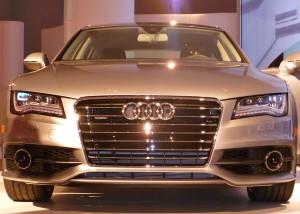
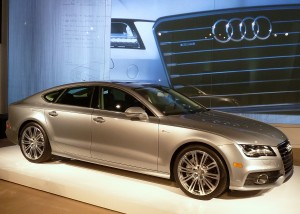
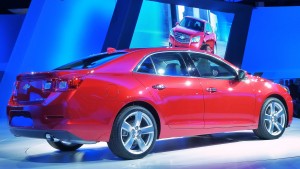
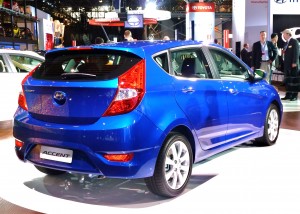

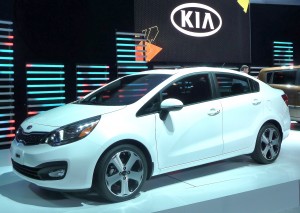
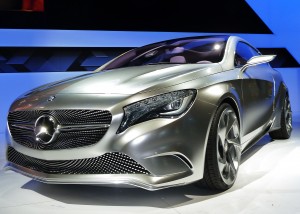
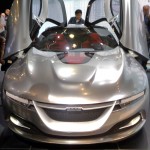
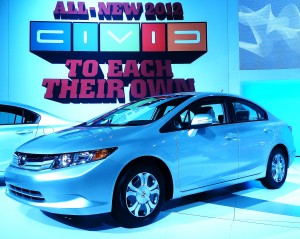
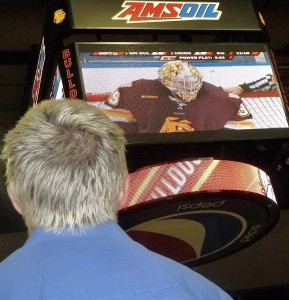

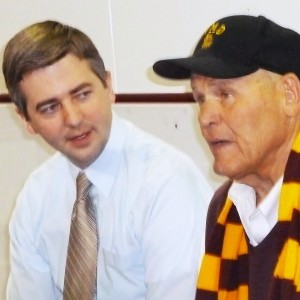
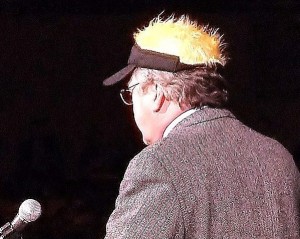
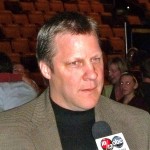
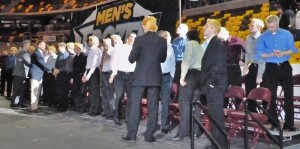
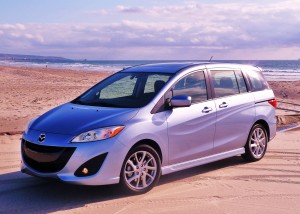
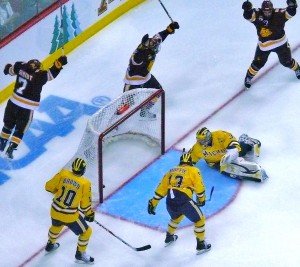
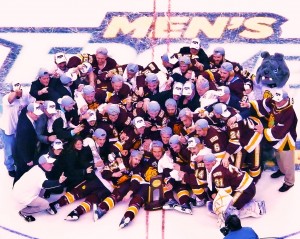
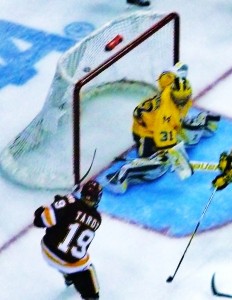
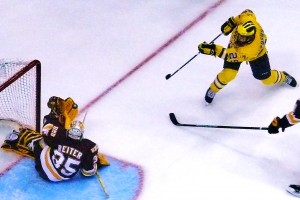
 John Gilbert is a lifetime Minnesotan and career journalist, specializing in cars and sports during and since spending 30 years at the Minneapolis Tribune, now the Star Tribune. More recently, he has continued translating the high-tech world of autos and sharing his passionate insights as a freelance writer/photographer/broadcaster. A member of the prestigious North American Car and Truck of the Year jury since 1993. John can be heard Monday-Friday from 9-11am on 610 KDAL(www.kdal610.com) on the "John Gilbert Show," and writes a column in the Duluth Reader.
John Gilbert is a lifetime Minnesotan and career journalist, specializing in cars and sports during and since spending 30 years at the Minneapolis Tribune, now the Star Tribune. More recently, he has continued translating the high-tech world of autos and sharing his passionate insights as a freelance writer/photographer/broadcaster. A member of the prestigious North American Car and Truck of the Year jury since 1993. John can be heard Monday-Friday from 9-11am on 610 KDAL(www.kdal610.com) on the "John Gilbert Show," and writes a column in the Duluth Reader.